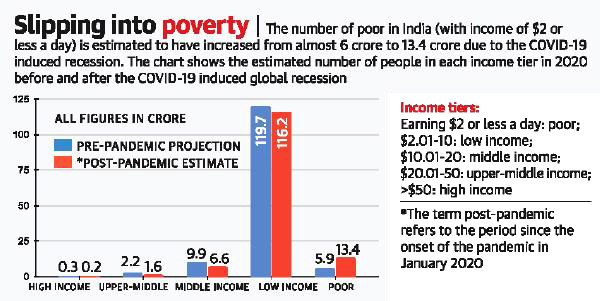Covid Increased Poverty: Pew Report | 20 Mar 2021
Why in News
Recently, a new research conducted by Pew Research Center has found that the coronavirus pandemic has pushed about 32 million Indians out of the middle class and increased poverty in the country.
- The report is based on an analysis of World Bank data.
- Pew Research Center is a nonpartisan fact tank that informs the public about the issues, attitudes and trends shaping the world.
Key Points
- Indian Scenario:
- Poverty Rate:
- The poverty rate in India likely rose to 9.7% in 2020, up sharply from the January 2020 forecast of 4.3%.
- Increased Poverty:
- From 2011 to 2019, the number of poor in India was estimated to have reduced to 78 million from 340 million.
- In 2020, the number increased by 75 million.
- Poor: People with incomes of USD 2 or less a day.
- Increase in India accounts for nearly 60% of the global increase in poverty.
- Record increase in Mahatma Gandhi National Rural Employment Guarantee Scheme (MGNREGS) participants as proof that the poor were struggling to find work.
- Reduced Middle Class:
- The middle class in India is estimated to have shrunk by 3.2 crore in 2020.
- Middle Class: Includes people with incomes of approximately Rs. 700-1,500 or USD 10-20 per day.
- The middle income group is likely to have decreased from almost 10 crore to just 6.6 crore.
- The middle class in India is estimated to have shrunk by 3.2 crore in 2020.
- Shrinked Low Income Group:
- The vast majority of India’s population fall into the low income group.
- This group shrank from 119.7 crore to 116.2 crore per day, with about 3.5 crore dropping below the poverty line.
- Low Income Group: Includes people earning about Rs.150 to 700 per day.
- Rich Population:
- The richer population also fell almost 30% to 1.8 crore people.
- Rich: Includes the people who earn more than Rs.1,500 a day.
- The richer population also fell almost 30% to 1.8 crore people.
- Poverty Rate:
- Comparison with China:
- Like India, China has a large population of around 1.4 billion people. But the pandemic’s effect on poverty was much smaller in China.
- It was the only major economy to grow in 2020 and that has helped poverty levels to remain “virtually unchanged”.
- In January 2021, the International Monetary Fund in its World Economic Outlook Report, estimated India’s economy to contract 8% in the Financial Year (FY) 2020 while China’s economy was expected to expand by 2.3% in 2020.
- China’s middle class is likely to see a miniscule dip of just one crore, while the number of poor people may have gone up by 10 lakh.
- Global Scenario:
- Poverty Rate:
- The global poverty rate also increased to 10.4% last year after witnessing a steady decline over the years.
- It was previously expected that the poverty rate would decrease to 8.7% in 2020.
- Poor Class:
- The number of ‘global poor’ are estimated to have increased to 803 million in 2020, which is a significant increase from 672 million, the pre-pandemic prediction.
- Middle Class:
- From 2011 to 2019, the middle class population globally had increased to 1.34 billion from 899 million. Further, it was expected to increase by 54 million annually on average.
- South Asia:
- South Asia saw the greatest reduction in the number of middle class and the largest ‘expansion’ in poverty in 2020.
- This could be attributed to South Asia experiencing sharp decrease in economic growth during the pandemic.
- South Asia saw the greatest reduction in the number of middle class and the largest ‘expansion’ in poverty in 2020.
- Poverty Rate:
- Reason:
- The lockdown triggered by the pandemic resulted in shut businesses, lost jobs and falling incomes, plunging the Indian economy into a deep recession.
- Sharp rise in global poverty was owing to the fact that many under the low income tier prior to the pandemic were living on the margin of poverty.
- Effect:
- India and China also account for more than a third of the global population, with about 1.4 billion people each, the course of the pandemic in these two countries and how each recovers will have a substantial effect on changes in the distribution of income at the global level.
- It claws back several years of progress on the economic front.
- At least 271 million people were lifted out of multi-dimensional poverty between 2005-06 and 2016-17, claimed India’s Voluntary National Review (VNR) of Sustainable Development Goals (SDG).
- Indian Initiatives to Mitigate the Effects of Covid:

